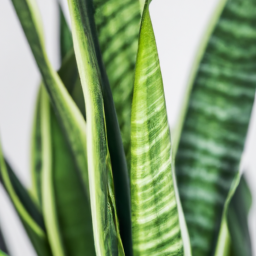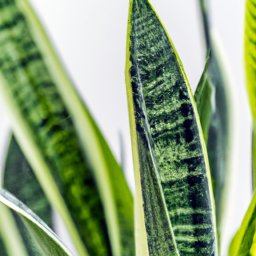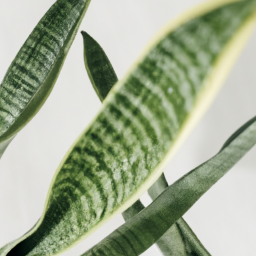
Are you looking to add some greenery to your home or office space? If so, you may want to consider different kinds of snake plants. These unique and low-maintenance plants are perfect for anyone looking to bring a touch of nature indoors. In this blog post, we will explore the various types of snake plants available and provide some tips on how to care for them. So, whether you’re a seasoned plant enthusiast or just starting out, keep reading to learn more about these fascinating plants.
Varieties of Snake Plants
Sansevieria Trifasciata
When it comes to snake plants, one of the most popular varieties is the Sansevieria Trifasciata. This plant is known for its long, sword-shaped leaves that are dark green with light green horizontal stripes. It is a hardy plant that can thrive in a variety of conditions, making it a great choice for beginners. The Sansevieria Trifasciata is also known for its air-purifying properties, making it a great addition to any indoor space.
One of the most common cultivars of the Sansevieria Trifasciata is the ‘Laurentii’, which has yellow margins on its leaves, adding a pop of color to any room. Another popular cultivar is the ‘Moonshine’, which has silvery-green leaves that give it a more modern and sleek look. Overall, the Sansevieria Trifasciata is a versatile and beautiful plant that is sure to brighten up any space.
Sansevieria Cylindrica
Another popular variety of snake plant is the Sansevieria Cylindrica, also known as the cylindrical snake plant or African spear. This plant is characterized by its long, cylindrical leaves that grow upright and can reach heights of up to three feet. The Sansevieria Cylindrica is a unique and striking plant that is sure to make a statement in any room.
One of the most popular cultivars of the Sansevieria Cylindrica is the ‘Boncel’, which has shorter leaves that are more tightly packed together, giving it a denser look. Another popular cultivar is the ‘Starfish’, which has leaves that fan out in a star-like pattern, adding a touch of whimsy to any space. The Sansevieria Cylindrica is a low-maintenance plant that is perfect for beginners and experienced plant owners alike.
Sansevieria Hahnii
The Sansevieria Hahnii, also known as the bird’s nest snake plant, is a compact variety of snake plant that is perfect for small spaces. This plant is characterized by its rosette of leaves that grow in a tight cluster, resembling a bird’s nest. The Sansevieria Hahnii is a great choice for tabletops, shelves, or desks, as it does not require a lot of space to thrive.
One of the most popular cultivars of the Sansevieria Hahnii is the ‘Golden Hahnii’, which has leaves that are variegated with shades of green and yellow, adding a pop of color to any room. Another popular cultivar is the ‘Black Coral’, which has dark green leaves that give it a more dramatic and sophisticated look. The Sansevieria Hahnii is a versatile and beautiful plant that is sure to enhance any indoor space.

Characteristics of Different Snake Plant Species
Sansevieria trifasciata
Sansevieria trifasciata, also known as the Mother-in-Law’s Tongue, is one of the most common types of snake plants. It is characterized by its long, upright leaves that are typically green with yellow edges. This plant is known for its air-purifying properties, making it a popular choice for indoor spaces. The Sansevieria trifasciata is a low-maintenance plant that thrives in a variety of light conditions, making it perfect for beginners.
One of the key characteristics of the Sansevieria trifasciata is its ability to tolerate low light conditions. This makes it an ideal plant for offices or rooms with limited natural light. Additionally, this plant is known for its durability and ability to withstand neglect, making it a great choice for those who may not have a green thumb.
In terms of care, the Sansevieria trifasciata prefers well-draining soil and only needs to be watered sparingly. Overwatering can lead to root rot, so it is important to let the soil dry out between waterings. This plant also benefits from occasional fertilization during the growing season to promote healthy growth.
Sansevieria cylindrica
Sansevieria cylindrica, also known as the Cylindrical Snake Plant, is a unique variety of snake plant that is characterized by its long, cylindrical leaves. Unlike the traditional flat leaves of other snake plant species, the Sansevieria cylindrica has round, smooth leaves that add a modern touch to any space. This plant is known for its striking appearance and is a popular choice for contemporary home decor.
One of the key characteristics of the Sansevieria cylindrica is its ability to thrive in bright, indirect light. While this plant can tolerate low light conditions, it will grow best in a spot with plenty of natural light. Additionally, the Sansevieria cylindrica is a slow-growing plant, making it perfect for those who prefer low-maintenance houseplants.
In terms of care, the Sansevieria cylindrica prefers well-draining soil and only needs to be watered when the top inch of soil is dry. This plant is drought-tolerant and can withstand periods of neglect, making it a great choice for busy plant owners. It is important to avoid overwatering, as this can lead to root rot and other issues.
Sansevieria moonshine
Sansevieria moonshine, also known as the Moonshine Snake Plant, is a unique variety of snake plant that is characterized by its silvery-green leaves. This plant is a hybrid of the Sansevieria trifasciata and Sansevieria pearsonii, resulting in a striking plant with a modern aesthetic. The Sansevieria moonshine is a popular choice for contemporary home decor and is known for its air-purifying properties.
One of the key characteristics of the Sansevieria moonshine is its ability to thrive in a variety of light conditions. This plant can tolerate low light, but will grow best in bright, indirect light. The Sansevieria moonshine is a low-maintenance plant that is perfect for beginners and busy plant owners alike.
In terms of care, the Sansevieria moonshine prefers well-draining soil and only needs to be watered sparingly. This plant is drought-tolerant and can withstand periods of neglect, making it a great choice for those who may not have a green thumb. It is important to avoid overwatering, as this can lead to root rot and other issues.
Overall, there are many different species of snake plants to choose from, each with its own unique characteristics and care requirements. Whether you prefer the traditional look of the Sansevieria trifasciata or the modern aesthetic of the Sansevieria cylindrica, there is a snake plant species that is perfect for your home or office. With proper care and attention, these plants can thrive and add beauty to any space.

Growing and Caring for Various Types of Snake Plants
Understanding Different Types of Snake Plants
When it comes to growing and caring for snake plants, it’s important to understand that there are several different types to choose from. Each type has its own unique characteristics and requirements, so it’s essential to familiarize yourself with the specific needs of the variety you have chosen.
One popular type of snake plant is the Sansevieria trifasciata, also known as the Mother-in-Law’s Tongue. This variety is known for its long, upright leaves that are typically green with yellow edges. It is a hardy plant that can thrive in a variety of conditions, making it a great choice for beginners.
Another common type of snake plant is the Sansevieria cylindrica, or the African Spear. This variety has cylindrical leaves that grow in a fan shape, giving it a unique and striking appearance. It requires bright, indirect light and well-draining soil to thrive.
The Sansevieria zeylanica, or the Ceylon Bowstring Hemp, is another popular choice among snake plant enthusiasts. This variety has long, sword-shaped leaves that are dark green with light green horizontal stripes. It prefers bright, indirect light and moderate watering.
Tips for Growing and Caring for Snake Plants
When it comes to growing and caring for snake plants, there are a few key tips to keep in mind to ensure their health and longevity. First and foremost, snake plants thrive in bright, indirect light, so be sure to place them near a window where they can receive plenty of sunlight without being exposed to direct rays.
In terms of watering, snake plants are relatively low-maintenance and prefer to dry out between waterings. Overwatering can lead to root rot, so it’s important to let the soil dry out completely before watering again. In general, snake plants do well with watering once every 2-3 weeks, depending on the humidity levels in your home.
Snake plants are also relatively resilient to pests and diseases, but it’s still important to keep an eye out for any signs of trouble. Common issues to watch for include yellowing leaves, mushy stems, and pests such as spider mites or mealybugs. If you notice any of these issues, take action promptly to prevent further damage.
Propagating Snake Plants
One of the great things about snake plants is that they are easy to propagate, making it simple to expand your collection or share with friends and family. There are several methods you can use to propagate snake plants, including division, leaf cuttings, and rhizome cuttings.
To propagate a snake plant through division, simply remove the plant from its pot and carefully separate the rhizomes into smaller sections. Be sure to include both roots and leaves in each section, then replant them in fresh soil and water thoroughly.
Leaf cuttings are another popular method of propagating snake plants. Simply cut a healthy leaf into 2-3 inch sections and allow them to callus over for a few days. Then, plant the cuttings in a well-draining soil mix and water lightly. Over time, new shoots will emerge from the cuttings, forming new plants.
Rhizome cuttings are similar to division, but instead of separating the rhizomes, you can cut them into smaller sections and replant them in fresh soil. Be sure to water the cuttings thoroughly and place them in a warm, bright location to encourage growth.
In conclusion, growing and caring for snake plants is a rewarding experience that can bring beauty and greenery into your home. By understanding the different types of snake plants available, following key care tips, and learning how to propagate them, you can enjoy these unique and resilient plants for years to come.
Let’s bring it all home
Snake plants, also known as Sansevieria, are a popular choice for indoor plants due to their low maintenance and air-purifying qualities. There are several different varieties of snake plants, each with its own unique characteristics. The most common type is the Sansevieria trifasciata, also known as the mother-in-law’s tongue, which has long, upright leaves with green and yellow stripes. Another popular variety is the Sansevieria cylindrica, which has cylindrical leaves that grow in a fan shape.
For those looking for a more unique snake plant, the Sansevieria masoniana, also known as the whale fin snake plant, is a great option. This variety has wide, paddle-shaped leaves that resemble a whale’s fin. The Sansevieria boncel, or starfish snake plant, is another interesting variety with short, stubby leaves that grow in a star-like pattern. No matter which type of snake plant you choose, you can be sure that it will add a touch of greenery and style to your home while also improving air quality.
Check Out These FAQs:
Q1: What are the different kinds of snake plants?
A1: There are several varieties of snake plants, including the popular Sansevieria trifasciata, also known as the mother-in-law’s tongue. Other varieties include Sansevieria cylindrica, Sansevieria masoniana, and Sansevieria francisii.
Q2: How can I differentiate between the different kinds of snake plants?
A2: Each variety of snake plant has its own unique characteristics. Sansevieria trifasciata has long, pointed leaves with yellow edges, while Sansevieria cylindrica has cylindrical leaves that grow upright. Sansevieria masoniana has broad, paddle-shaped leaves, and Sansevieria francisii has shorter, stubbier leaves.
Q3: Are there any rare or exotic varieties of snake plants?
A3: Yes, there are rare and exotic varieties of snake plants, such as Sansevieria ballyi, Sansevieria kirkii, and Sansevieria hallii. These varieties may have unique leaf shapes, colors, or patterns that make them stand out from more common varieties.
Q4: Can snake plants be grown indoors and outdoors?
A4: Snake plants are versatile and can be grown both indoors and outdoors, depending on the climate. They thrive in bright, indirect light and can tolerate low light conditions indoors. Outdoors, snake plants prefer partial shade and well-draining soil.
Q5: How do I care for different kinds of snake plants?
A5: Snake plants are low-maintenance and easy to care for. They prefer well-draining soil and only need to be watered sparingly, allowing the soil to dry out between waterings. Regularly dusting the leaves and occasionally fertilizing during the growing season will help keep your snake plants healthy and thriving.
Dr. Olivia Green is a botanist with over two decades of experience in indoor plant cultivation. She holds a Ph.D. in Plant Biology and has dedicated her career to researching plant behavior in controlled environments. Dr. Green is passionate about helping plant enthusiasts master the art of indoor gardening through her extensive knowledge and practical insights.


